![]()
Featured Harp Guitar of the Month
G. A. Carlson c.1900 Harp Guitar
by Gregg Miner, September, 2014
| Meanwhile, on a (then) unrelated topic, I had earlier
snagged this wonderful image from eBay (should have gotten the
original!).
As always, I do my best to identify the instrument in these fascinating photographs. This gentleman's harp guitar didn't match anything in the Galleries, though it bore many suspicious similarities to this one-of-a-kind specimen by one Henry G. Tabbert of Cleveland, Ohio:
|
|
| Specifically, the body was the same, it had a
large, offset soundhole and the same placement of the two necks.
Additionally, there was that straight, tapered bridge
(increasing from treble to bass side), and a vaguely similar
sub-bass head array with pin tuners, affixed to the main head
via an extension. I thus postulated that the instrument in
the group photo might also be a Tabbert instrument.
|
|
| Then about two years someone listed on eBay a second harp guitar by G. A. Carlson. It had the same label as the first, but the instrument had a slightly different design. | ||
|
As it was in pretty poor shape, I passed on it, but grabbed the small photos, noticing the curious headstock logo (at left). I also remembered seeing this style of harp guitar before - of course! It reminded me of both the Tabbert and that old historical player's instrument. That enabled me to safely switch the historical player's instrument from "attributed to" Tabbert to "att G. A. Carlson. |
||
| But I still had lousy, incomplete photos of this Carlson from eBay...until this year, when the previous buyer put it back on eBay and I was able to acquire it (see Blog). Here it is, after restoration: | ||
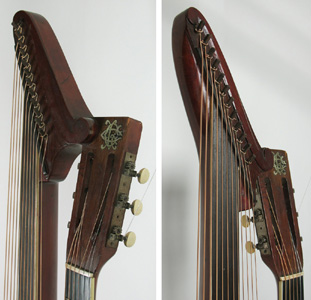 |
I already knew that it wasn't the exact same specimen as in the historical photo, as the carved sub-bass head piece had a slightly different shape. But it's a very close match! |
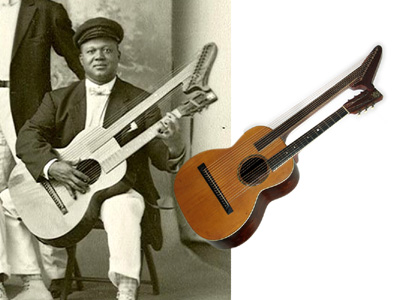 |
| I was anxious to analyze the overly elaborate pearl logo,
which we imagined spelled out the maker's initials.
But where did one end and another begin?! |
The "C" was easy: | As was the "G"...
...which leaves whatever is left as some sort of crazy "A"? |
The previous owner had repaired a few cracks (leaving many to go) and also replaced the bridge. Sadly, he replaced the split original Brazilian rosewood bridge with ebony. We decided to leave it when we determined that the wood underneath had not been addressed, thinking it less risky to trust it would hold tension than to remove the bridge which would have almost certainly made more of a mess and require a potentially visible top patch (the inside bridge plate is all but non-existent). In the end, the top remained incredibly flat and the bridge has not ripped off, even with 18 light to extra light strings tuned to pitch. |
|
|
It is now possible to say with a large degree of
certainty that one of the unusual harp guitars in the New York Clef
Club Orchestra photo from 1911 (at right) is also a G. A. Carlson
instrument (see "James
Reese Europe and the Clef Club Orchestra"). Though fuzzy, we can see what is likely the same logo on the headstock. It also has the same bass headstock design with 12 subs tuned with pins, the large offset soundhole, and the straight tapering bridge, with an additional medallion-like piece added. |
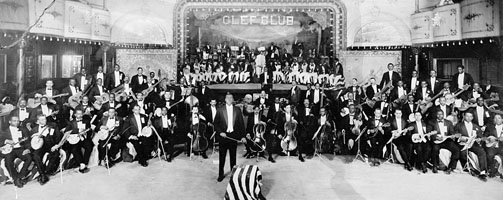 |
| I had never been able to discover any other info
on G. A.
Carlson, so was happy to find him under Musical Instruments in the 1900
Chicago directory, under the name Gustav A. Carlson, 753 W. 63rd.
This is a couple doors down from the 741 W. 63rd listed on his labels,
but doesn't tell us how long he was in business. He doesn't appear
in either the 1892 or 1910 directories like Bohmann, his colleague across
town. Presumably, he came and went. Searching has unearthed no G. A. Carlson mandolins or standard guitars. So far, his output remains these four harp guitars, two of which survive. |
||
|
Or is it five? While taking one last look at the Clef Club harp guitars above, I noticed at the end of the article the small 1905 photo of Ernest Hogan's group with its 3 or 4 harp guitars. In grayscale or enhanced to show the outline of of the left instrument, not only do I see the same bass headstock shape, but what looks like our infamous "G-A-C" pearl headstock logo! As Hogan's players may have later joined the Clef Club (which Hogan protégé' James Reese Europe directed), it's certainly possible that it is actually the same instrument. |
|
|
|
And what of Henry Tabbert, who first clouded the issue above? Again, nothing is known of the Cleveland maker, but I have to assume that the two builders either knew each other or that one saw and copied the others' work. |
|
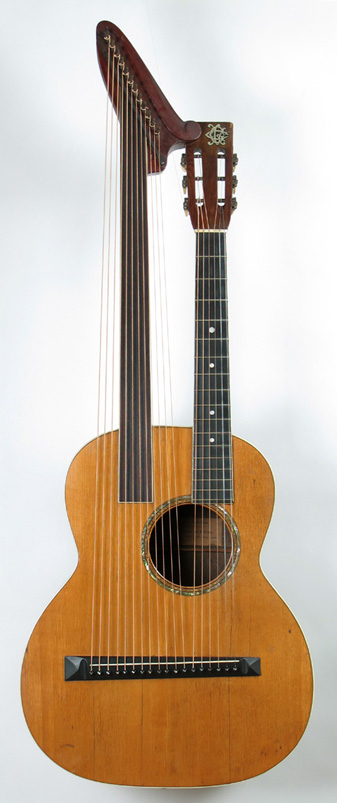 Gustav A. Carlson, Chicago, IL, c.1900 Miner Museum collection |
Note how the two most distinctive features are shared: the large offset soundhole and the straight, tapering bridge. Add to that a similar double-neck and bass head configuration, with each having twelve long sub-bass strings tuned with pins. The Tabbert owners describe it as a much cruder instrument than Carlson's. He was listed in a city directory, but was probably a part time builder. |
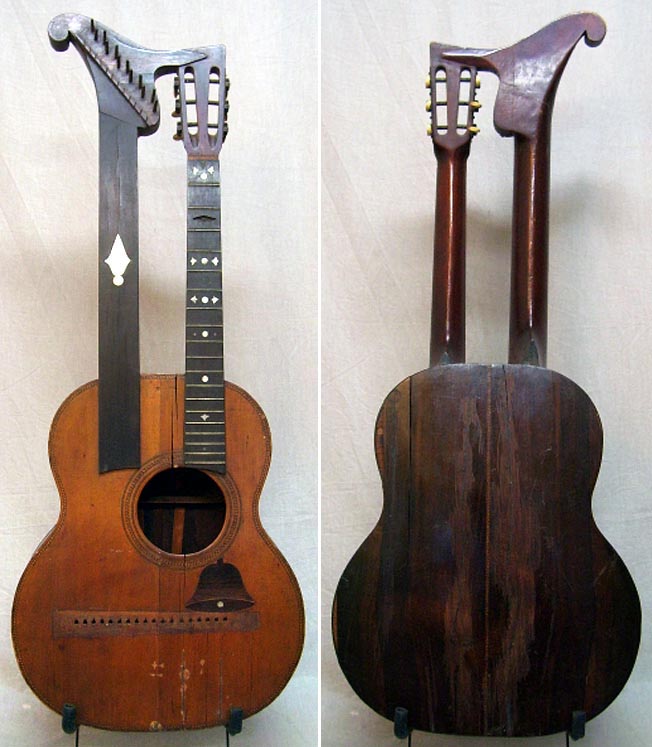
Henry Tabbert, Cleveland, OH, c.1900 Courtesy jfrenchbanjos.com, instrument owned by Smakula Fretted Instruments |
|
|
Epilogue: People
always ask about how these instruments were originally utilized, and I
always treasure finding evidence of the original owners of these
wonderful inventions.
Here, we can actually see
two of the ensembles that included the rare and obscure G. A. Carlson
harp guitars.
In the case of Europe’s orchestra, we can even hear
recordings of his groups and the strong, rhythmic drive of their Marches
and similar American music.
In concert, the Europe orchestra harp guitarists had to somehow
back up over a hundred musicians of all types: banjos, horns, drums and
multiple pianos.
They therefore really had just one musical criterion for their
instruments: they had to be loud.
And
G. A. Carlson delivered! |
|
|
Harp Guitar of the Month: Archives |
| Collectors,
Authors, Scholars: Want to create a page about a certain harp guitar
maker or instrument? Contact
me!
If you enjoyed this article, or found it useful for research, please consider supporting Harpguitars.net so that this information will be available for others like you and to future generations. Thanks!
|
|
If you enjoyed this article, or found it
useful for research, please consider making a donation to The
Harp Guitar Foundation, |
|
|
|
All Site Contents Copyright © Gregg Miner, 2004, 2005, 2006, 2007, 2008, 2009, 2010, 2011, 2012, 2013,2014. All Rights Reserved. Copyright and Fair Use of material and use of images: See Copyright and Fair Use policy. |